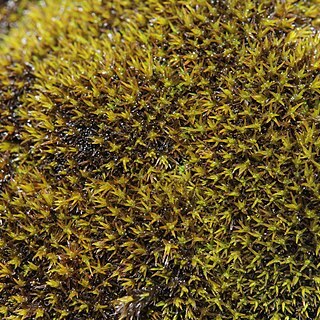Gametophyte. Dioicous. Female: innermost perichaetial leaf 2.8-3.5 mm long, sheathing up to mid-leaf, from ovate, elongated base constricted above mid-leaf to narrow upper part, leaf base hyaline, some rows of hyaline cells vanishing above broadest part, costa stout, excurrent into short, weakly denticulate hair-point; male: plants in separate cushions, perigonia as small buds on short stalks in leaf axils, several per stem, innermost perigonial leaf 0.7 mm, sheathing, ovate, strongly keeled, apex muticous, acute, hyaline up to broadest part, costa percurrent, paraphyses few. Growth form: cushion dense, disintegrating easily, young shoots originating from older stems, leaflets muticous, appressed to stem, plants somewhat radiculose at base, erect, branched, stem up to 40 mm high, thin, central strand poorly developed, occasionally lacking. Leaves 1.2-1.8 mm long, imbricate, in short-leaved form appressed to stem, in long-leaved form slightly twisted and loosely disposed on stem when dry, bending back-wards when moistened, leaf base appressed to stem, laminal part patent, from narrow oval leaf base elongate-lanceolate, straight or somewhat falcate, on one side above broadest part markedly narrowed to apical part, thus forming shoulder, on nearly straight side margin recurved from leaf base up to mid-leaf, short leaves muticous, slightly cucullate, longer leaves apiculate, hair-point short, smoothly denticulate; leaf form in situ, at insertion and leaf base concave, at transitional part lamina spreading from costa, lower laminal part keeled, upper part narrowly so, margin at one side from insertion up to mid-leaf recurved; basal cells elongate-rectangular, walls smooth except some cell rows between margin and paracostal cells with faintly nodulose walls, at margin 3-4rows narrowly elongate-rectangular, hyaline, thin-walled cells, gradually vanishing, outermost row ascending up to above broadest part of leaf, cells becoming short-rectangular to quad-rate, walls more or less sinuose, in upper laminal part oval to isodiametric, lumina rounded, walls thickened; seen in trans-verse section, leaf base unistratose, lamina in places or entirely bistratose, margin unistratose at leaf base, in laminal part some cell rows bi-or tristratose. Costa, seen on dorsal side, weak at leaf base, stout in laminal part, reaching apex, in upper part dorsal cells similar in shape to proximate lamina cells, seen in transverse section, costa on dorsal side rounded at insertion and leaf base, occasionally prominent in laminal part, in rare cases faintly mammillose, on ventral side at insertion and leaf base widely channelled, in middle part of lamina narrowly so, keeled in apical part, at insertion and leaf base 4 guide cells, in laminal part 2 guide cells, at insertion and leaf base substereids, in upperpart cells rounded, homogeneous, hydroids from insertion up to mid-leaf. Sporophyte. Seta erect, inclined or arcuate, 2.0-3.5 mm long, vaginula 0.8-1.2 mm long, cylindrical, ochrea small. Capsule emergent, erect, inclined or cernuous, ovoid or obloid, smooth, exothecial cells of variable shape, isodiametrically or elongated penta-and hexagonal, walls curvilinear, slightly thickened, stomata more or less numerous at capsule base, annulus of 2-3 rows of cells detaching singly, the lumen narrow, round. Calyptra mitrate-cucullate. Operculum conical, blunt, margin smooth of two rows of rounded cells, in conical part ovate, walls thickened. Peristome teeth erect or recurved when dry, broad at base, rarely slit or perforate, inner and upper outer side covered with rough, rounded and sharp papillae, lower outer side sparingly ornamented with fine papillae, trabeculae thin, scarcely protruding in lower part, conspicuously protruding in upper part. Spores 12-16 µm, granulose.
More
Plants in dense patches, reddish brown to blackish green. Stems 1-4 cm, central strand present. Leaves lanceolate, keeled, not plicate, one margin commonly narrowly recurved, awns 0.1-0.5 mm, lower leaves muticous, costal transverse section weak at base, semicircular distally; basal juxtacostal laminal cells elongate, straight, somewhat thick-walled; basal marginal laminal cells rectangular with straight walls, often hyaline; medial laminal cells short-rectangular, sinuose, thick-walled; distal laminal cells 1-stratose, not bulging, marginal cells 2-stratose, not bulging. Sexual condition dioicous, perichaetial leaves not enlarged. Seta straight to slightly arcuate, 1.5-2.5 mm. Capsule occasionally present, emergent to shortly exserted, yellow-brown, ovoid, exothecial cells variable, quadrate to rectangular, thin-walled, stomata present, annulus of 1-3 rows, operculum conical to rostrate, peristome present, fully-developed, papillose.

